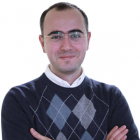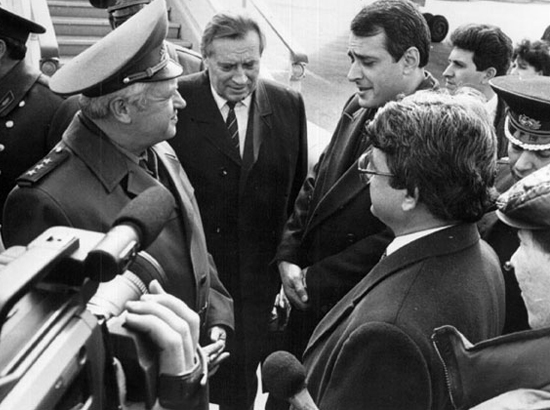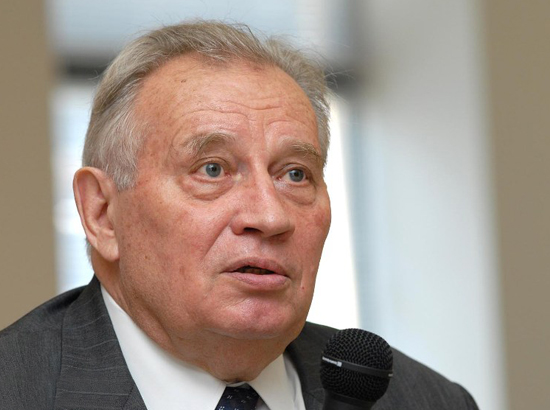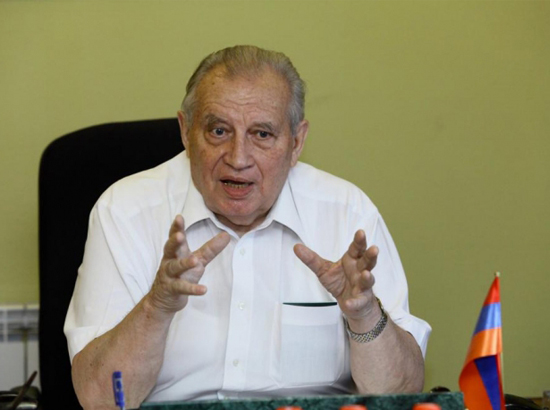Mediamax’s interview with head of Russian mediatory mission, Russian President’s Special Envoy for Nagorno Karabakh in 1992-1996
- Thomas de Waal writes in his “Black Garden”: “The problem for the Russian Foreign Ministry was that, for obvious reasons, it had no experience in the republics of the former Soviet Union. It had plenty of specialists on France or Vietnam, but none in a region, which had only just ceased to be part of the same state. This was one reason that the Defense Ministry, with thousands of men on the ground in the Caucasus, was able to play a leading role.” How real was the problem and how unanimous were the approaches of the Russian Foreign Ministry and Defense Ministry headed by Pavel Grachev to the conflict?
- Relations between Foreign Ministry and Defense Ministry of Russia were really complicated. Much is known about Defense Minister Pavel Grachev’s peacekeeping ambitions. The initial impulse of the ambitions was a reasonable and correct one but the practical fulfillment deliberately doomed it to failure especially because of his underrating of the interdepartmental coordination of actions.
The agreement concluded between Armenian and Azerbaijani Defense Ministers in Sochi on September 1992 was one of the vivid examples of his unauthorized activities. It envisaged ceasefire and moratoriums on all the types of military actions for 2 months. Partially, it borrowed the essence of the proposals made by Russia in CSCE Minsk Group in early August 1992. But Grachev didn’t coordinate his project with Russian Foreign Ministry which evoked a number of absurdities, deprived of Ukraine’s, Belarus’, Kazakhstan’s and Georgia’s support and entailed the failure of the agreement. I happened to deliver Russian President’s message to Elchibey to Baku the previous day but nobody informed me that Grachev was planning a meeting in Sochi.
Later on, to settle discords among the two departments, I put the address of the Defense Minister the first among addressees contained in the Ceasefire Agreement signed in May 1994.
- Today, people often link the ceasefire to May 5 Bishkek Protocol forgetting that the Ceasefire Agreement was based on the Statement of the Council of CIS Heads of State made on April 15, 1994 which contained the more categorical formulations on the need for terminating military actions. How did the parties come to agreement on this?
- UN Security Council Resolutions which enforcement was undermined by the sides didn’t underlie May 12, 1994 Ceasefire yet. We needed a new document with distinct directions.
On April 15, the Council of CIS Heads of State upon Russia’s initiative made a key Statement in Moscow which clearly set the issue of ceasefire as a pressing need for Karabakh settlement.
By that time, there hadn’t been any comprehensive document on Karabakh which would be adopted on a high-level and with direct involvement of Azerbaijani and Armenian Presidents. The Supreme Forum of Commonwealth confirmed “the Top 3” urgent requirements - immediate ceasefire, termination of all the military actions and its reliable confirmation and liquidation of outcomes of the conflict as a result. The Council again turned to the international community, CSCE and UN calling for support to Commonwealth’s measures toward the conflict settlement. It’s a pity many political scientists and journalists don’t know the real role of the Document.
And the very Ceasefire Agreement differed from the previous ones first of all because it didn’t mention any date - thus it was an open-ended document. Besides, in accord with the Moscow conception, it was signed not by 2 as earlier but all the 3 conflicting sides (not only Baku and Stepanakert, but also Yerevan).
- In your speeches, you noted that “Bishkek was only an auxiliary link”. What was the importance of Bishkek and what were the main results?
- The meeting of the speakers of the parliaments of the conflicting sides in Bishkek was aimed at supporting the Statement of the Heads of State. At that moment, it was important to retarget the public opinion to truce and ceasefire. Earlier, back in Moscow, I worked out the draft of the document, Bishkek Protocol, around which heated debates and persistent discussions unfolded - mainly between the Azerbaijan and Karabakh representatives which lasted for long hours on May 4 and 5.
The proposal to support the provisions of the Statement of CIS Heads of State in itself didn’t evoke any discussions. Besides, the new document was aimed at calling upon the speakers of the parliaments of all the conflicting sides to cease fire by May 9, Victory Day. We wanted to use the date. But the discords among the sides on other issues weren’t settled.
Naturally, Armenia’s representative Babken Ararktsyan and especially Karabakh representative Karen Baburyan stood up for the status of Nagorno Karabakh as a conflicting side and participant of Bishkek meeting in every way possible. Afiyaddin Djalilov, Deputy Chairman of the Azerbaijani parliament, advocated earliest ceasefire more than Armenians but he insisted upon immediate withdrawal of Armenian troops from the occupied Azerbaijani territories and repatriation of refugees. But it was evident that Djalilov didn’t at all stress on ways of reaching nonrenewal of military actions: he obviously shun the idea of deployment of neutral dividing forces and was ready to settle for observers.
Later on May 5, after really exhausting debates, the Bishkek Protocol was signed by leaders of both Armenian delegations and all the mediators. Afiyaddin Djalilov was the only one to have refused to sign the document. He came up with inarticulate excuses that the document didn’t meet their interests. As it turned out, it was only an excuse. The real reason was Heydar Aliyev’s participation in the session of NATO Council in Brussels during those days and his signing of a framework document of “Partnership for Peace” program. His trip and speech in NATO Headquarters (which contained no single mention of Russia or CIS in the context of the conflict) already made part of a geopolitical “zigzag” game into which the Azerbaijani leader was involved under the pressure from Western powers.
On May 21 of the same year, Aliyev publicly stated that he blocked the signing of the protocol in good time by not giving Djalilov such privileges. In Bishkek, naturally we didn’t know about Aliyev’s instructions and that’s why he flew to Baku to find out the final position of Azerbaijan to Bishkek document on May 7.
- How did your negotiations proceed in Baku?
- A meeting with participation of Azerbaijani senior leadership was held in Heydar Aliyev's office on May 8 and I was also present at it. Despite the Azerbaijanis' initial scepsis toward Bishkek document, soon a turn to compromise loomed. The participants of the meeting voiced the ideas of signing of the document with amendments though - someone proposed to add the word ''international'' before ''mediators'' and someone offered to replace the phrase ''occupied territories'' with ''captured'' ones. On my part, I explained however I could that there was no real point in introducing amendments into the text as the remaining participants of the meeting in Bishkek signed the document in the initial form and they wouldn’t revise it.
The traditional “sore spot” of Baku diplomacy also played its role: again they started insisting upon Nizami Bakhmanov’s signature on behalf of the Azerbaijani community of Nagorno Karabakh. I proved them that Bakhmanov can’t be equaled to leaders of the representative structures but the Azerbaijani participants’ interest was beyond any logical arguments.
Eventually, the Azerbaijanis expressed the readiness to sign the protocol with the mentioned reserve and with Bakhmanov’s signature. Speaker of the parliament Guliyev signed, and two “reservations” were added in Russian with legible handwriting under it. Other important but delicate provisions of the document (reference to the Protocol of Defense Ministers of February 18, CIS role and the idea of creating their own peacekeeping forces) weren’t touched upon.
The idea of Bakhman’s signature ended up in an awkward situation. The Azerbaijanis also inserted his surname by hand but they didn’t manage to find him in Baku in time. Informing Moscow about Guliyev’s signing of Bishkek Protocol, I took my copy of the text with the two reservations and inserted surname of Bakhmanov but without his signature .
- Once you said that “the Ceasefire Agreement was signed in a “monstrous” way, meaning there was no such case in the world practice”. What did you mean? In which conditions was the Ceasefire Agreement eventually signed?
-By early May 1994, the Azerbaijani leadership was interested in ceasefire. Earlier, either they were not willing to take the step or they piled up preconditions which were knowingly unrealizable, or they broke agreements, but this time their desire was more persistent and was expressed on the highest level. It should be noted that Baku this time didn’t advance any preconditions for ceasefire.
I worked out the first draft of the Ceasefire Agreement on the same basis as before - between Baku and Stepanakert. But Azerbaijanis, who elaborated documents on restrictions of military actions with Stepanakert without Yerevan’s involvement for exactly 10 times before, now agreed to sign the Agreement only with Armenian representatives but without the Armenians of the Nagorno Karabakh.
Yerevan wasn’t willing to sign anything without Stepanakert’s participation and Azerbaijanis didn’t want to put their signatures beside Karabakh representatives, and at their presence especially. There are “technologies” which allow signing documents separately, that means - without direct meeting of the sides around a table, but Baku representatives didn’t want it either.
There turned out to be an absurd dead-end: all the conflicting sides were concerted about the ceasefire but the problem was whose signatures would be put in the document. We had to immediately use the readiness of all the sides to cease the fire and somehow bypass their stubborn unwillingness not to meet to properly sign a joint document.
Over these 2 years, we already had the experience of “facsimile” diplomacy when we had to agree with the sides on the phone and then confirm it through fax.
We worked out the text of the agreement in Heydar Aliyev’s office who was President back then in Baku. As a result, Heydar Aliyev “blessed” the Defense Ministry M. Mammadov on May 9 to sign the text comprising 4 points. It designated the post of another “signer”, NK Army Commander. But he was due to sign the same list and there was exactly the same text with the same Moscow addressees in Stepanakert. I sent the same text from Baku to be signed in Stepanakert. At the end of the day, Heydar Aliyev again asked me to call Yerevan and tried to manage to get Armenia’s signature. I rang up but I didn’t think they would agree to sign. However, in 1.5 hours I suddenly received Yerevan’s consent which met our conception of the configuration of the conflict. I had to insert by hand “Minister of Defense of Armenia” (which is also seen in the photo copy of the document) between the two printed “signers”. Azerbaijani Defense Minister Mammadov again signed in the list with my addition and I flew to Moscow.
On May 10, I received the final text with the signature of Armenia’s Defense Minister Serzh Sargsyan. On May 11, I got a fax from Stepanakert with the same “lonely” signature of the Commander of NK Defense Army Samvel Babayan. I immediately informed all the three parties about the completion of the signing procedure, faxed the sheets with other signatures to each side in a crisscross manner and as a mediator, announced the Agreement came into force on May 12, 1994.
That is why the Agreement doesn’t have a common original or copies signed by representatives of all the three parties. There were no seals, sealing wax and fancy folders. It wasn’t required and there was no approval by the parliaments while the people definitely approved of it.
- Initially, there was a plan on introduction of peacekeeping troops into the conflict zone, the so-called ''Grachev's Plan'' which is registered in the Ceasefire Agreement as well. But the issue was eliminated from the agenda. Why did it happen?
- The Ceasefire Agreement didn't contain such common means of confirming the ceasefire as withdrawal of the conflicting sides' forces and heavy weapons from the contact line, establishment of a buffer zone, placement of neutral observers or dividing forces, control measures and international guarantees. The reason was that a part of the issues would be addressed during the meeting of Azerbaijani and Armenian Defense Ministers and Commander of NK Defense Army with Grachev's participation.
The meeting in Moscow was held on May 16-17, 1994. Grachev who was obviously upset with the intractability of the Ministers quite impulsively chose to speak in an extremely abrupt and almost ultimatum tone of a diktat while talking to journalists, and the media covered it in ''bright colors'' on the very next day. So, it was the measures toward strengthening of ceasefire regime in the deployment of the conflict zone of Russian peacekeepers that were worked out and mostly approved at the meeting.
But Grachev wasn’t the only one with strained nerves. On the same day, Heydar Aliyev assigned his Minister Mammadov not to sign the document worked out at the meeting and immediately return to Baku allegedly to be given additional instructions. On May 17, together with Mammadov, we flew to Baku. On May 1 8, Aliyev received him and instructed not to sign the Moscow document. Aliyev explained to me Mammadov's calling off to Baku by Grachev's improperly abrupt tone, but evidently there were more profound reasons for that.
When Mammadov and I again returned to Moscow on May 19, the Azerbaijani Minister started putting forward new conditions not to sign the drafted document at the meeting with Deputy Defense Minister of Russia Kondratyev. He tried to link the withdrawal of troops with withdrawal of Armenian forces from the occupied territories though it was already more of a military-political than military-technical issue which should have been addressed within ''a major political agreement''.
At that time, Azerbaijan underwent a major pressure from Western states. The West was upset with ceasefire with Russia's mediation, and the prospect of deployment of Russian peacekeeping structures would be unacceptable for them. It's evident from extreme activation of Minsk Group leadership after May 12 and from the whole dynamics of Western diplomacy on Karabakh over the whole 1994. All their efforts were aimed at designating at least the prospect of sending observers and OSCE peacekeeping forces - merely not to allow stationing of Russian and other CIS countries' forces. So, Aliyev didn't endure this pressure and gave a command for another zigzag in its policy - to West's direction this time.
Azerbaijan's retirement from the means of strengthening ceasefire didn't allow thoroughly consolidating the agreement in military-technical terms. As a result, the ceasefire wasn't properly reinforced by Russia or West and objectively remained relatively vulnerable. Mostly it was because despite the protocol of Defense Ministers' meeting in Moscow on February 1, 1994, Baku refused to withdraw troops from the contact line. That is why - and on the whole, because of the ''crude'' policy of Azerbaijan - there are numerous sad incidents on the contact line.
Aram Araratyan talked to Vladimir Kazimirov

























Comments
Dear visitors, You can place your opinion on the material using your Facebook account. Please, be polite and follow our simple rules: you are not allowed to make off - topic comments, place advertisements, use abusive and filthy language. The editorial staff reserves the right to moderate and delete comments in case of breach of the rules.